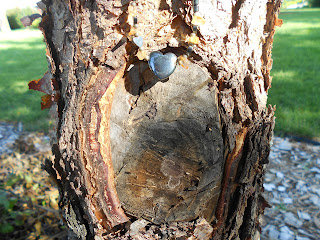R-strategist: (pincher bug) An r-strategist is an organism that adapts to its unstable and unpredictable environment by reproducing massive amounts of offspring at once. Traits associated with r-strategists include: small body size, early maturity onset, short generation time, and the ability to disperse offspring widely. Insects are a simple example of an r-strategist, as are frogs and rodents.
Cambium: (tree branch) In plants, a layer of actively dividing cells between the xylem and the phloem tissues that is responsible for the secondary growth of stems and roots. A cambium may also form within callus tissues- masses of cells that grow over the injured surface of a wound, leading to healing. In this picture, the cambium is shown as the light layer just under the exterior bark.
Vestigal structure: (dewclaw on dog) a structure of marginal, if any, importance to an organism. Vestigal structures are historical remnants of structures that had important functions in ancestors. A dog's dewclaw, also called dog's thumb, is a fifth claw that grows high upon the paw and rarely touches ground, providing no advantage to a dog for walking. May be used for gripping when running but for the most part is useless to function of the paw.
Mycelium: (wild mushroom) The densely branched network of hyphae in a fungus. The mycelium is much like the root of the mushroom and branches out to anchor the plant into the soil. Shown here in the picture, on the brown end of the mushroom, there are tiny mycelium hairs, remnants from where I pulled the mushroom out of its colony.
Phloem: (tree trunk) a vascular plant tissue consisting of living cells arranged into elongated tubes that transport sugar and other organic nutrients throughout the plant. Phloem is found just under the cambium and bark of a tree, surrounding the deeper set xylem, as shown in this cut from a tree trunk.





No comments:
Post a Comment
Note: Only a member of this blog may post a comment.